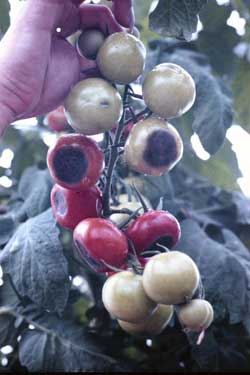Blossom end rot: transport protein identified

Blossom end rot on tomatoes<br>Picture: Agroscope<br>
Now a Korean-Swiss research team under the co-leadership of plant physiologists at the University of Zurich identified a protein that regulates calcium transport in the plant root and up to the shoot. For plant breeding, the specific transport protein provides a first step toward correcting deficiency symptoms in food plants.
Blossom end rot on tomatoes and cucumbers, spotty apples – these unpleasant blemishes on fruits and vegetables not only compromises the flavor but also causes significant harvest losses every year. The characteristic blotches and spotting can be traced back to insufficient calcium uptake or faulty calcium transport within the plant. Consequently, the damage can occur even if the soil provides sufficient calcium.
A team under the leadership of scientists from the University of Zurich and Pohang University of Science and Technology, Korea, has for the first time identified a protein which is responsible for the calcium transport from the root to the shoot. “Without this transport protein, plants exhibit stunted growth,” explains Enrico Martinoia, Professor for Molecular Plant Physiology at the University of Zurich.
Calcium uptake through the root epidermis
Calcium provides stable cell walls for plants and transmits signals within the cells. Calcium concentration varies within the plant depending on area, which requires complex regulation and transport mechanisms. How and from which tissue calcium ions are taken up by the roots and transported to the shoot of the plant was largely unknown before. In order to settle these questions, the scientists examined the cultivated plant Brassica Juncea, commonly known as brown or Indian mustard, and the model plant Arabidopsis thaliana, or thale cress. The researchers identified a specific transport protein which advances calcium ions from the root into the shoot.
In their article recently published in the Proceedings of the National Academy of Sciences, they also show that the calcium uptake occurs via the root epidermis and not through the endoderm as earlier presumed. The identification of the transport protein for calcium is a first step in eliminating the formidable deficiency symptoms in food plants.
Literature:
Wong-Yong Song, Kwan-Sam Choi, De Angeli Alexis, Enrico Martinoia and Youngsook Lee. Brassica juncea plant cadmium resistance 1 protein (PCR1) facilitates the radial transport of calcium in the root. PNAS. October 14, 2011. doi: 10.1073/pnas.1104905108
Contact:
Prof. Enrico Martinoia
Institute for Plant Biology
University of Zurich
8008 Zurich
Tel. +41 44 634 82 22
E-mail: enrico.martinoia@botinst.uzh.ch
Media Contact
More Information:
http://www.mediadesk.uzh.ch/All latest news from the category: Life Sciences and Chemistry
Articles and reports from the Life Sciences and chemistry area deal with applied and basic research into modern biology, chemistry and human medicine.
Valuable information can be found on a range of life sciences fields including bacteriology, biochemistry, bionics, bioinformatics, biophysics, biotechnology, genetics, geobotany, human biology, marine biology, microbiology, molecular biology, cellular biology, zoology, bioinorganic chemistry, microchemistry and environmental chemistry.
Newest articles

High-energy-density aqueous battery based on halogen multi-electron transfer
Traditional non-aqueous lithium-ion batteries have a high energy density, but their safety is compromised due to the flammable organic electrolytes they utilize. Aqueous batteries use water as the solvent for…

First-ever combined heart pump and pig kidney transplant
…gives new hope to patient with terminal illness. Surgeons at NYU Langone Health performed the first-ever combined mechanical heart pump and gene-edited pig kidney transplant surgery in a 54-year-old woman…

Biophysics: Testing how well biomarkers work
LMU researchers have developed a method to determine how reliably target proteins can be labeled using super-resolution fluorescence microscopy. Modern microscopy techniques make it possible to examine the inner workings…





















